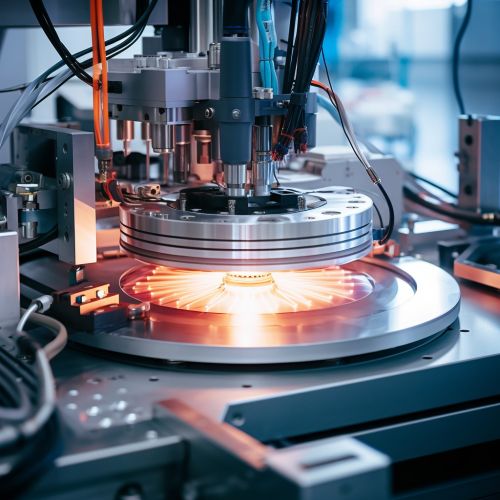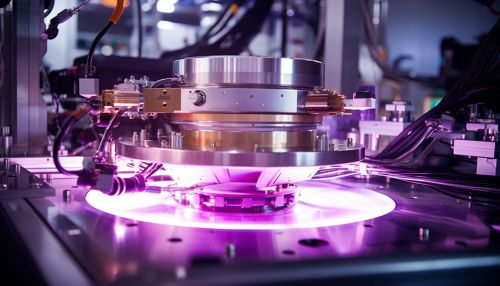Molecular Self-Assembly and Nanofabrication
Introduction
Molecular self-assembly is a process by which molecules adopt a defined arrangement without guidance or management from an outside source. This process is a key concept in nanotechnology and nanofabrication, where it is often used to create complex structures with nanometer precision. The process involves the spontaneous organization of molecules under thermodynamic conditions into stable, structurally well-defined aggregates joined by non-covalent bonds. Molecular self-assembly can be observed in various biological systems and has been used as a strategy in the design of new materials and devices at the nanometer scale.


Principles of Molecular Self-Assembly
Molecular self-assembly is driven by the system's tendency to minimize its free energy. The molecules are guided to an energetically favorable structure by intermolecular forces, such as van der Waals forces, electrostatic forces, π-π interactions, hydrogen bonding, and hydrophobic effects. The process of molecular self-assembly can be divided into two types: intramolecular self-assembly and intermolecular self-assembly.
Intramolecular Self-Assembly
In intramolecular self-assembly, a single molecule changes its shape to form a stable structure. This process is often seen in biological systems. For example, proteins and RNA molecules undergo intramolecular self-assembly to achieve their functional forms.
Intermolecular Self-Assembly
Intermolecular self-assembly involves the organization of separate molecules into an ordered structure. This is commonly observed in the formation of micelles, vesicles, liquid crystal phases, and crystals. The driving force for intermolecular self-assembly is typically non-covalent interactions.
Nanofabrication
Nanofabrication refers to the design and manufacture of devices with dimensions measured in nanometers. One of the key concepts of nanofabrication is the ability to manipulate individual atoms and molecules to create unique structures. There are two primary types of nanofabrication: 'top-down' and 'bottom-up'.
Top-Down Nanofabrication
Top-down nanofabrication is essentially a process of miniaturization. It starts with a bulk material and then carves out nanoscale structures from it. This approach is commonly used in conventional semiconductor fabrication where photolithography techniques are used to create integrated circuits.
Bottom-Up Nanofabrication
In contrast, bottom-up nanofabrication involves the assembly of atomic or molecular scale components into larger, more complex structures. This approach is often associated with molecular self-assembly, where individual molecules spontaneously organize into ordered structures.
Molecular Self-Assembly in Nanofabrication
Molecular self-assembly has been recognized as a potential method for nanofabrication due to its ability to create complex structures with precision. This approach has several advantages over traditional top-down nanofabrication methods. It allows for the fabrication of structures with higher complexity and better precision at the nanometer scale. Moreover, it can be performed under mild conditions and is often less expensive than top-down methods.
Molecular self-assembly can be used to create a wide range of structures, including two-dimensional (2D) and three-dimensional (3D) nanostructures. These structures can be used in various applications, such as in the fabrication of nanodevices, nanomedicine, and materials science.
Applications of Molecular Self-Assembly and Nanofabrication
The principles of molecular self-assembly and nanofabrication have been applied in various fields, including electronics, medicine, and materials science.
Electronics
In the field of electronics, molecular self-assembly is used to create nanoscale devices, such as transistors, sensors, and solar cells. For example, molecular self-assembly can be used to create a monolayer of molecules that can act as a semiconductor.
Medicine
In medicine, molecular self-assembly has been used to create nanostructures for drug delivery. These nanostructures can be designed to deliver drugs to specific locations in the body, improving the efficacy of the drug and reducing side effects.
Materials Science
In materials science, molecular self-assembly is used to create new materials with unique properties. For example, self-assembled monolayers (SAMs) can be used to create surfaces with specific chemical and physical properties.
Conclusion
Molecular self-assembly and nanofabrication are key concepts in nanotechnology. The ability to manipulate molecules and atoms to create structures with nanometer precision has opened up new possibilities in various fields, including electronics, medicine, and materials science. As our understanding of these processes continues to grow, so too will their potential applications.
